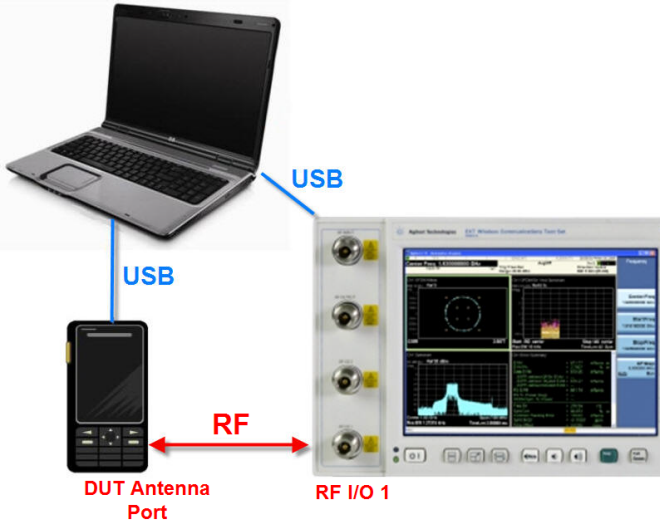Connect to a DUT (Device Under Test)
The EXT test set is generally used in a non-signaling test environment, in which the cellular mobile device under test does not engage in actual call-processing with a base station or base-station emulator. In the absence of call-processing, the mobile device must be tested by other means.
Because mobile devices (and modes on the same device) differ so greatly, setting up a non-signaling test requires very detailed knowledge of that device’s characteristics and test requirements. Such information is not only device-specific, it is also the private intellectual property of the device manufacturer, and cannot be shared here.
Although the requirements of non-signaling test vary greatly from one device to another, they typically include the following elements:
- Test modes are designed into the DUT itself, and activated either by commands from a PC controller or by an RF stimulus from the test set.
- Proprietary software tools are provided by the maker of the mobile device, for the purpose of communicating with the DUT from a PC controller and activating whatever device functions are required during a test.
- An RF stimulus is applied by the test set to the DUT, using an ARB waveform file that includes any encoding (synchronization channels, for example) which the DUT must receive during testing. Although the test set is not a base-station emulator, the RF stimulus it provides can mimic the expected input from a base station to a sufficient degree to support testing of this kind.
- A software tool (such as Agilent Signal Studio) is used to create ARB waveforms which the test set will play during testing.
- Signal analysis measurements are made on the RF output from the DUT, including a wide variety of measurements and radio formats (all of which can be included within one test sequence).
- A test sequence is created (typically using Sequence Studio) for time-coordination between the test set’s stimulus and measurement operations and the DUT’s transmit and receive operations.
In a typical test setup, the PC controller communicates with the DUT and with the EXT test set by way of USB cables. RF signals are exchanged bi-directionally between the DUT’s antenna port and one of the set’s RF I/O ports.


